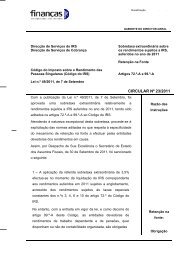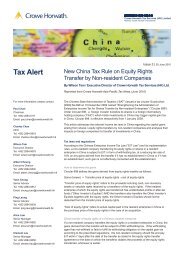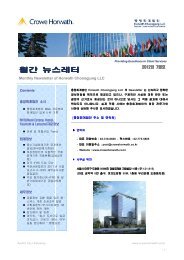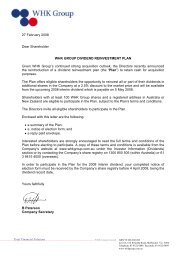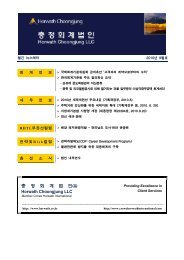Guidance Paper - The Institute of Risk Management
Guidance Paper - The Institute of Risk Management
Guidance Paper - The Institute of Risk Management
Create successful ePaper yourself
Turn your PDF publications into a flip-book with our unique Google optimized e-Paper software.
<strong>Risk</strong> <strong>Management</strong><br />
Maturity<br />
206<br />
<strong>Risk</strong> management maturity is<br />
an increasingly familiar<br />
concept. Many organisations<br />
have developed risk<br />
management maturity models which cover<br />
a variety <strong>of</strong> attributes. Some address the<br />
maturity <strong>of</strong> risk management and control<br />
processes, some consider the culture <strong>of</strong><br />
risk management, and some consider the<br />
preparedness <strong>of</strong> the organisation to face<br />
up to (or be susceptible to) disaster.<br />
We think that there are four<br />
207 dimensions <strong>of</strong> risk<br />
management maturity that a<br />
board should consider in<br />
determining its preparedness to embark<br />
on a risk appetite exercise. <strong>The</strong>se are:<br />
• <strong>The</strong> business context: This includes<br />
understanding the state <strong>of</strong><br />
development <strong>of</strong> the business, its size,<br />
industry sector, geographical spread<br />
and the complexity <strong>of</strong> the business<br />
model. <strong>The</strong>re is little advantage to<br />
an organisation in defining a risk<br />
appetite that is not based firmly in the<br />
context <strong>of</strong> the business. A wide variety<br />
<strong>of</strong> business factors will influence the<br />
risk appetite and some examples <strong>of</strong><br />
these are set out in the table below.<br />
In essence a good understanding <strong>of</strong><br />
the business model is an essential first<br />
step in determining how much risk the<br />
business is currently engaging with<br />
and how much more it might wish to<br />
engage with in the future.<br />
• <strong>Risk</strong> management culture: This<br />
addresses the extent to which the<br />
board (and its relevant committees),<br />
management, staff and relevant<br />
regulators understand and embrace<br />
the risk management systems and<br />
processes <strong>of</strong> the organisation. <strong>The</strong><br />
ability to determine, manage and<br />
monitor a risk appetite will depend<br />
to a large extent on the maturity<br />
<strong>of</strong> the risk management culture<br />
within the organisation. Where the<br />
attitude to risk management is one<br />
<strong>of</strong> indifference, or a sense that risk<br />
management is little more than a<br />
bureaucratic paper chase, then the<br />
likelihood <strong>of</strong> developing an effective<br />
risk appetite is remote. Equally, it<br />
is essential that the tone for risk<br />
management is set from the top: if<br />
the chairman and chief executive are<br />
indifferent, then that will most likely<br />
be reflected in attitudes further down<br />
through the organisation.<br />
• <strong>Risk</strong> management processes: This<br />
refers to the extent to which there are<br />
processes for identifying, assessing,<br />
responding to and reporting on<br />
risks and risk responses within the<br />
organisation. <strong>The</strong>re are some common<br />
factors that should be present in all<br />
risk management processes, namely<br />
risk identification, risk assessment and<br />
risk monitoring and reporting. <strong>The</strong><br />
issues that need to be understood<br />
include the extent to which these are<br />
common across the organisation, the<br />
extent to which there is a common<br />
language across the business and<br />
above all whether gathering and<br />
reporting all <strong>of</strong> the risk management<br />
information makes any difference<br />
to the way in which the business is<br />
run. As we said earlier, setting a risk<br />
appetite is only a worthwhile exercise<br />
if you, as an organisation, are able to<br />
manage the risk to the level at which<br />
it is set. This implies the need for<br />
effective risk management processes.<br />
• <strong>Risk</strong> management systems: This<br />
means the extent to which there are<br />
appropriate IT and other systems<br />
to support the risk management<br />
processes. Most organisations have<br />
comprehensive and effective systems<br />
for collecting rearward looking key<br />
performance indicators (KPIs): namely<br />
accounting systems. IT systems,<br />
people, responsibilities and so on<br />
are all well-defined in a more or<br />
less smoothly operating system. Few<br />
organisations have similar approaches<br />
to managing forward looking issues:<br />
in other words the systems (in the<br />
broadest sense <strong>of</strong> the word) are<br />
rarely subject to the same extent <strong>of</strong><br />
rigour or complexity. Increasingly we<br />
anticipate that organisations will need<br />
to collect, process and disseminate<br />
risk information across the business in<br />
order to be truly effective.<br />
19






